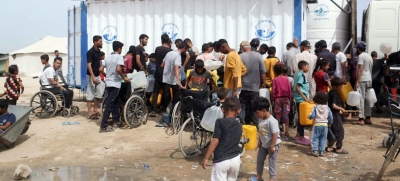A decades-long conflict in the Caucasus flared up this week, as Azerbaijan on Tuesday launched an “anti-terror” strike aimed at Nagorno-Karabakh — the semi-autonomous, majority-Armenian region within its internationally recognized borders.
For the second time in three years, Azerbaijan’s government made decisive gains: the government of Nagorno-Karabakh has agreed to dissolve its military, and the future of the region’s semi-autonomous status has been put into serious doubt. It’s a result that could echo far beyond Azerbaijan’s borders, as it has escalated an already difficult humanitarian crisis, and is roiling Armenian politics.
Though there’s no suggestion of imminent war between the neighbors, regional experts said there is concern that continued crises like last week’s strike could inflame longstanding tensions, resulting in continued conflict between Armenia and Azerbaijan that could also pull in other regional powers like Iran and Turkey.
“This could become a regional war,” Benyamin Poghosyan, Senior Fellow on Foreign Policy at the Applied Policy Research Institute of Armenia, an independent think tank in Yerevan, told Vox. At the very least, he said, “I am afraid that for years to come […] the South Caucasus and Armenia and Azerbaijan will be volatile.”
This week’s crisis in Nagorno-Karabakh, explained
The trouble in Nagorno-Karabakh didn’t just start this past week. The region has been the locus of conflict between Armenia and Azerbaijan since the collapse of the Soviet Union, but animosity between the two countries goes back to the turn of the 20th century.
After the region was absorbed into the USSR, the Soviet Union designated a majority-Armenian autonomous region within Azerbaijan in 1923 — today known as Nagorno-Karabakh.
Conflict between Nagorno-Karabakh and Azerbaijan started in earnest in 1988, when the region began agitating for independence. Between 1988 and 1990, Azerbaijan carried out multiple pogroms against Armenians within its borders, and interethnic conflict was common. Moscow intervened in 1990, and in the aftermath of the dissolution of the USSR Nagorno-Karabakh claimed independence, though the international community has never recognized the breakaway republic.
That move inflamed tensions between Azerbaijan and Armenians in Nagorno-Karabakh. Backed by Armenian troops, Karabakh Armenians took control not only of their historical region, but also of much of Azerbaijan’s territory up to the border with Armenia.
That conflict, which ended with a 1994 ceasefire, was a huge moral victory for Armenia, according to Poghosyan, who said that territorial gain was “one of the primary pillars of independent Armenian identity,” after centuries of oppression.
But it was also an unsustainable loss for Azerbaijan — about 20 percent of its territory was now outside of the country’s control.
Azerbaijan, aligned with Turkey, recaptured significant territory in a 2020 war. During that conflict, Russia, which has long been Armenia’s military partner, failed to back Armenia and Karabakh Armenians. That conflict ended in a Russia brokered ceasefire, which about 2,000 Russian peacekeepers have helped ensure.
Cut to this week: On September 19, Azerbaijan launched an “anti-terror” campaign in response to the deaths of six people in two landmine explosions within Azerbaijan.
US Secretary of State Antony Blinken called for an immediate halt to the hostilities, which displaced at least 7,000 and killed around 200, with thousands reportedly still missing.
Authorities in Nagorno-Karabakh accused Azerbaijan on Wednesday of violating the ceasefire agreement, though Azerbaijan vehemently denied the claim. There were also reports of heavy gunfire Thursday, but because mobile connectivity and electricity are only sporadically available in the region, verifying claims from either party is nearly impossible.
Talks between Azerbaijan’s government and representatives from Nagorno-Karabakh’s capital, which Armenians call Stepanakert and Azerbaijan refers to as Khankendi, are continuing. “We have an agreement on the cessation of military action but we await a final agreement — talks are going on,” David Babayan, who advises the head of Nagorno-Karabakh’s breakaway government Samvel Shahramanyan, told Reuters Thursday.
In addition to dissolving the armed forces, Zaur Shiriyev, the International Crisis Group’s analyst for the South Caucasus told Vox via email that the ceasefire agreement includes, “the dismantling of all existing de facto institutions, [political] positions, and symbols, and discussions about the integration of local Armenians under Azerbaijani authority,” including how to implement some autonomy at the municipal level and protect Armenian language and customs. That would suggest Nagorno-Karabakh’s semi-autonomous government may not be in existence for much longer, and that the way of life the region’s residents have known may be coming to an end.
What Azerbaijan decides to do about Nagorno-Karabakh affects the whole region
Nagorno-Karabakh, like other potential territorial conflicts, is an issue of great political volatility of the issue within Armenia, because the territory is also an issue of national pride and identity for many Armenians, and because it is a way to gauge Armenia’s power and influence in the region.
That influence has waned somewhat as Azerbaijan’s military might has grown, aided by increased oil and gas wealth and a security partnership with Turkey, and as Armenia’s relationship with Russia has diminished.
Under current Prime Minister Nikol Pashnyan, the Armenian government has distanced itself both from Russia and from Nagorno-Karabakh, insisting that the Armenian government has had nothing to do with the agreement between Azerbaijan and the de facto government in Stepanekert, and even backing off of previous hard-line guarantees for the region like autonomous rule, Paghosyan told Vox. Armenia was reluctant to get involved in this latest outbreak of fighting; Pashinyan said he wouldn’t let the country be “drag[ged] … into military operations.”
Russia, which helped broker peace in 2020, has also seen its role in the region greatly reduced. Russian peacekeepers have been present maintaining the 2020 ceasefire, but their influence has softened over the years, particularly due to Russia’s invasion of Ukraine. And their presence has, at best, only been able to keep an uneasy peace, with low-level hostilities common in the region.
“The ongoing war in Ukraine has indeed weakened Russia’s role, and since 2022, coupled with [Azerbaijan’s] checkpoint in Lachin, and the recent brief war that ended with the capitulation of local Armenians, Azerbaijan has gained more control over the region’s affairs than Russia had previously,” Shiriyev said.
Russia has also struggled with maintaining the flow of goods and people across the region’s only physical connection to Armenia, the Lachin corridor. That area’s been severely restricted by Azerbaijan since December 2022, Shiriyev said.
“Even before last December, when Azerbaijani-backed activists started protests near the road demanding Azerbaijani control, Baku alleged that the road was being used for unchecked transfers of weapons and natural resources from the region to Armenia,” he explained. In April of this year, Azerbaijan established a border checkpoint on the Lachin corridor, over time choking off transport completely. Since that time, the humanitarian situation in Nagorno-Karabakh has become increasingly desperate, and only one humanitarian convoy, from the International Committee of the Red Cross, has been permitted to enter the region in months.
Despite Russia’s reduced status in the region, the country is still playing an administrative role in this conflict, facilitating discussions between the Azerbaijani government and local Armenian authorities. “Nowadays, if disarmament takes place, the Russian forces will play a part in it, and over time, they will coordinate the implementation of other ceasefire terms,” Shiriyev told Vox. “Baku views [Russia’s] role as a stabilizing factor, especially in areas where local Armenians live.”
The future looks challenging for Pashinyan as his internal opposition — which is friendlier with Russia than he is — is harnessing protests and frustration with Pashinyan over Nagorno-Karabakh to try and get him to resign. “Protests erupted quite spontaneously and only afterwards political opposition wanted to take them over,” Meliqset Panosian, an independent researcher based in Gyumri, told Vox.
What’s all but guaranteed, Poghosyan said, is continued conflict and possible regional destabilization. Many in Armenia “are feeling humiliated,” he told Vox; to restore their dignity “they will be more inclined to have more nationalistic views.” Armenia is courting other security partners in addition to Russia, and could aspire to build up its military over the coming years. While it’s decidedly the weaker of the two states, it’s not above military conflict. The interests of Russia, Turkey, Western countries, and even Iran overlap and conflict in the region, meaning the potential for animosity and outright hostility remains.
What happens now? Honestly, it’s hard to say
Despite the new agreement between Nagorno-Karabakh and Azerbaijan, there are still a great many unknowns — primarily what Karabakh Armenians’ lives would look like, should they decide to stay in the region. The terms of Wednesday’s ceasefire are still in flux, though Azerbaijan’s Aliyev has promised Karabakh Armenians a “paradise” as part of Azerbaijan.
In the immediate term, the first priority is for humanitarian aid to reach the people of Nagorno-Karabakh, since many in the area are already suffering from severe hunger, Poghosyan said.
There’s no indication as of yet that those who remain will enjoy autonomy; as Poghosyan said, Pashinyan’s only request, though he is not part of the negotiating process, is that ethnic Armenians have rights under Azerbaijani jurisdiction. Aliyev has promised that Armenians will enjoy the right to their own language and culture, but Armenians have expressed concerns about violence and even ethnic cleansing.
That’s not unfounded, given the region’s history. And according to a 2022 State Department report, evidence was found of Armenian graves being desecrated by Azeri soldiers, as well as “severe and grave human rights violations” against Armenians ethnic minorities, including “extrajudicial killings, torture and other ill-treatment and arbitrary detention, as well as the destruction of houses, schools and other civilian facilities.”
Those concerns make an exodus from Nagorno-Karabakh likely. Poghosyan estimates that 50,000 to 70,000 of the approximately 120,000 Karabakh Armenians will choose to leave their homes, and will look for safe passage either to Armenia or to other locations including Russia where they might settle.
“Now most of them want to leave to Armenia, almost nobody believes in peaceful coexistence with Azerbaijanis,” Stepan Adamyan, an Armenian who works with international journalists, told Vox. “Every hour [on Facebook] I read their posts saying “do something, take us out of here.”






